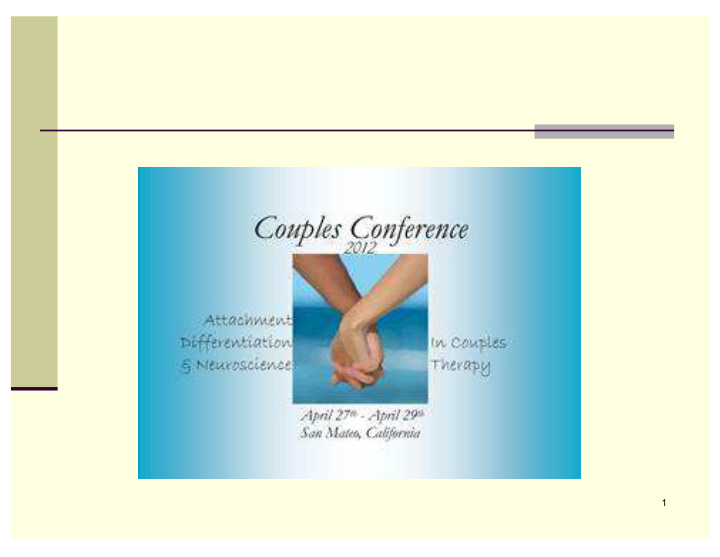



1
Using Positive Experiences To Heal Personal And Relational Wounds Love & Intimacy: The Couples Conference April 29, 2012 Rick Hanson, Ph.D. The Wellspring Institute for Neuroscience and Contemplative Wisdom WiseBrain.org RickHanson.net 2 drrh@comcast.net
Topics Antidote experiences Clearing old pain 3
Antidote Experiences 4
Choices . . . Or? Reactive Mode Responsive Mode 5
Psychological Antidotes Avoiding Harms Strength, efficacy --> Weakness, helplessness, pessimism Safety, security --> Alarm, anxiety Compassion for oneself and others --> Resentment, anger Attaining Rewards Satisfaction, fulfillment --> Frustration, disappointment Gladness, gratitude --> Sadness, discontentment, “blues” Attaching to Others Attunement, inclusion --> Not seen, rejected, left out Recognition, acknowledgement --> Inadequacy, shame Friendship, love --> Abandonment, feeling unloved or unlovable 6
How to Take in the Good 1. Look for positive facts, and let them become positive experiences. 2. Savor the positive experience: Sustain it for 10-20-30 seconds. Feel it in your body and emotions. Intensify it. 3. Sense and intend that the positive experience is soaking into your brain and body - registering deeply in emotional memory. 7
For an individual grappling with relationship issues, what might be a useful antidote experience? For each member of a couple, what might be a useful antidote experience? How could each member promote the other member’s antidote experience? 8
Clearing Old Pain 9
Using Memory Mechanisms to Help Heal Painful Experiences The machinery of memory: When explicit or implicit memory is reactivated, it is rebuilt from schematic elements, not retrieved in toto . When attention moves on, the memory gets reconsolidated. The open processes of memory reactivation and reconsolidation create a window of opportunity for shaping your internal world. Reactivated material associates with other things in awareness, especially if they are prominent and lasting. When memory returns to storage, it takes associations with it. 10 You can imbue memory with positive associations.
The Fourth Step of TIG When you are having a positive experience: Sense the current positive experience sinking down into old pain, and soothing and replacing it. When you are having a negative experience: Bring to mind a positive experience that is its antidote. In both cases, have the positive experience be big and strong, in the forefront of awareness, while the negative experience is small and in the background. You are not resisting negative experiences or getting attached to positive ones. You are being kind to yourself and cultivating positive resources in your mind. 11
TIG4 Capabilities, Resources, Skills Capabilities: Dividing attention Sustaining awareness of the negative material without getting sucked in (and even retraumatized) Resources: Self-compassion Internalized sense of affiliation Skills: Internalizing “antidotes” Accessing “the tip of the root” 12
Neuropsychology of TIG4 Extinction, through pairing a negative experience with a powerful positive one. Reinforces maintaining PFC-H activation and control during A- SNS arousal, so PFC-H is not swamped or hijacked Reinforcement of self-directed regulation of negative experiences; enhances sense of efficacy Dampens secondary associations to negative material; that reduces negative experiences and behavior, which also reduces vicious cycles Reduces defenses around negative material; thus more 13 amenable to therapeutic help, and to insight
TIG and Trauma General considerations: People vary in their resources and their traumas. Often the major action is with “failed protectors.” Cautions for awareness of internal states, including positive Respect “yellow lights” and the client’s pace. The first three steps of TIG are generally safe. Use them to build resources for tackling the trauma directly. As indicated, use the fourth step of TIG to address the peripheral features and themes of the trauma. Then, with care, use the fourth step to get at the heart of 14 the trauma.
The Tip of the Root For the fourth step of TIG, try to get at the youngest, most vulnerable layer of painful material. The “tip of the root” is commonly in childhood. In general, the brain is most responsive to negative experiences in early childhood. Prerequisites Understanding the need to get at younger layers Compassion and support for the inner child Capacity to “presence” young material without flooding 15
Psychological Antidotes Avoiding Harms Strength, efficacy --> Weakness, helplessness, pessimism Safety, security --> Alarm, anxiety Compassion for oneself and others --> Resentment, anger Attaining Rewards Satisfaction, fulfillment --> Frustration, disappointment Gladness, gratitude --> Sadness, discontentment, “blues” Attaching to Others Attunement, inclusion --> Not seen, rejected, left out Recognition, acknowledgement --> Inadequacy, shame Friendship, love --> Abandonment, feeling unloved or unlovable 16
For an individual grappling with relationship issues, what’s the negative material, what’s an antidote experience, and how might you pair them? For each member of a couple, what’s the negative material, what’s an antidote experience, and how might you pair them? 17
True Nature Peaceful Happy Loving 18
Where to Find Rick Hanson Online http://www.youtube.com/BuddhasBrain http://www.facebook.com/BuddhasBrain w www.RickHanson.net www.WiseBrain.org 19 19
Recommend
More recommend